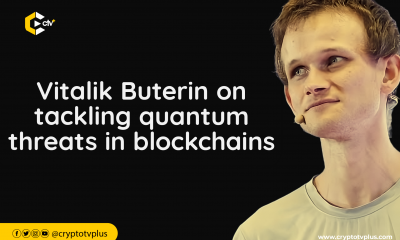Education
How to make money with layer two blockchains in 2023

The year 2022 was challenging for crypto users and investors; the majority of people lost money as a result of cyber security flaws that allowed for hacking, phishing, and other cyber-attacks. According to a report, cyberattacks accounted for 95.6% of all attacks, with fraud, scams, and rug pulls making for the remaining 4.4% of losses in 2022. Decentralized finance (Defi) was reportedly the most targeted industry in 2022, with losses reaching 80.5% bringing the total amount of stolen cryptocurrency to $3.9 billion.
Some countries have taken a strict stance on the use of cryptocurrencies, while others have adopted a more permissive approach. In some cases, governments have outright banned the use of cryptocurrencies, making it harder for people to own cryptocurrency. The value of cryptocurrencies significantly dropped due to the collapse of the crypto market causing investors to lose money.
How do investors bounce back?
What could be done to make the new year pleasant?
How do we find our way back to making money?
These are questions a lot of people ask.
Layer 2 comes to mind when considering a strategic concept to start the year and potentially recoup from last year’s setback. Layer 2 projects have been gaining traction and usage, due to the rising fees and transaction throughput. So, instead of playing catch-up all the time, let’s check out how to make money with layer 2 blockchains.
Let’s go!
First, what are layer 2 Solutions?
Layer 2 refers to a set of protocols that allows the creation of smart contracts and Decentralized apps (dApps) on top of the blockchain.
Layer-2 solutions are networks that run on top of a layer-1 blockchain technology to enhance its scalability and functionality. With this technique, Layer-1 can transfer a portion of its transactional workload to a nearby network, which will then handle the processing requirements for each transaction and transmit it back to the primary blockchain to complete it.
The base layer blockchain is made less crowded and ultimately more scalable by transferring a significant portion of processing power to an external network.
In essence, Layer 1 focuses on security, data availability, and decentralization, while Layer 2 focuses on scaling in connection to transactions.
Why Layer 2?
Scalability is one of the major challenges facing blockchain technology. This is in terms of a blockchain network’s ability to handle numerous transactions quickly.
Since blockchains are decentralized and rely on consensus, each transaction must be verified by several network nodes, which can be a time-consuming process.
Due to this limitation, the layer 1 blockchain can only process a certain number of transactions per second, which is unsustainable to keep up with the rising demand. That’s why the Layer 2 solution was introduced. To improve scalability, Layer 2 is added on top of the basic chain.
Layer 2 solutions are crucial for increasing scale. It serves as the network’s processing layer for all transactions.
Layer 2 solutions allow for faster transaction rates and scaling while maintaining the security of the main chain. They can execute thousands of transactions per second in some circumstances, which is required to enable a network to reach widespread adoption.
Examples of layer 2s on Ethereum include solutions like Arbitrum, Optimism, Loopring, and zkSync. Other examples of Layer-2 solutions include:
Nested blockchains: A blockchain that is stacked on top of another blockchain is called a nest. The main chain may specify conditions, assign work to nested chains, which will process it, and then return it to the main chain when finished. Through this division of labour, the main chain’s processing load is lessened, and scaling is made possible.
State channels: Boosts transaction capacity and speed by enabling interoperable communication between a blockchain and an off-chain channel. To deploy its solutions to the blockchain and off-ramp channel, it typically uses smart contracts or multi-signature (multi-sig) technology. The transaction is transferred over and recorded on the underlying blockchain once it has been completed on the state channel. State channels include the Lightning Network for Bitcoin and the Raiden Network for Ethereum.
Sidechains: Refers to a network that is generally utilized for large transactions and is situated “by the side” of a blockchain. It is typically created from scratch, sidechains employ their independent consensus mechanism that can be accelerated and scaled.
How to make money with layer two blockchains in 2023
1. Staking
Staking is a term used to describe the locking up of funds (crypto) to help safeguard a specific blockchain network or smart contract technology. Staking is also extensively utilized for cryptocurrency transactions aimed at providing Defi liquidity, gaining access to yield benefits, and acquiring governance rights.
Staking is a method of receiving incentives for holding particular cryptocurrencies. Some layer two blockchains, such as Ethereum’s Optimistic Rollup, offer a staking feature that allows you to earn a return on your investment.
Your cryptocurrency generates rewards while being staked because the blockchain utilizes it.
2. Running a validator node
Cryptocurrency has now made it possible for token owners to become validators or nodes by using their resources and computers.
Who Is a Crypto Validator?
In a blockchain network, a validator is a node or participant who is in charge of approving transactions and adding new blocks. In a blockchain network, transactions are broadcast to all nodes, but by confirming the accuracy of the transactions, validators play a critical role in maintaining the integrity and security of the network. These people support blockchains and cryptocurrencies in general.
Additionally, they serve as a gatekeeper to stop harmful or invalid transactions from being uploaded to the blockchain, maintaining the network’s security.
Being a validator is a crucial function that calls for a particular level of technical proficiency, familiarity with blockchain technology, and dedication to upholding the network’s security and integrity.
Validators use a consensus mechanism to agree on the order and state of transactions on the blockchain. In a proof-of-work (PoW) consensus mechanism, validators called “miners” use computational power to solve complex mathematical problems and add new blocks to the chain. In a proof-of-stake (PoS) consensus mechanism, validators are chosen to create new blocks based on the amount of stake or cryptocurrency they have locked up as collateral.
Validators get paid in crypto for their work. But there are a few requirements you need to meet to have a chance of becoming a validator.
To be a validator, you need to stake a certain amount of crypto for a chance of being randomly selected for the task. The minimum staking amounts differ depending on the coin in question, but this can vary massively.
There are several ways to make money as a blockchain validator
- Transaction Fees: The collection of transaction fees is one of the most typical ways validators earn. These are minor charges that customers pay when they conduct a transaction on the blockchain. To be compensated for your part in validating and documenting the transactions, validators are entitled to a fraction of these fees.
- Block Rewards: In some blockchain networks, validators can earn block rewards for creating new blocks.
- Staking: To earn by staking as a validator, you must lock up a specific amount of tokens. Your staked tokens will earn interest as you verify transactions and support network security.
- Investment or donation: Some validators may receive funding or donations from various sources according to the network type. For instance, a corporate organization might choose to host a validator node to promote the network or an open-source project might provide grants to validators who want to maintain a node.
- Professional Services: Some validators might provide organizations interested in using the blockchain with expert services. These services could be in the form of advising, development, or instruction.
Note: A validator’s income potential can vary significantly based on the blockchain network and the particular role they play. Additionally, it’s critical to realize that being a blockchain validator is a technical job that demands technical skills and knowledge.
What do you need to be a validator?
To be a validator on a blockchain network, you typically need the following:
- An 8GB RAM computer and a significant quantity of free storage space—roughly 250GB—on your chosen validating device.
- Technical knowledge: An understanding of blockchain technology, including consensus methods, network design, and cryptography, as well as a certain level of technical proficiency is necessary to be a validator.
- Strong computer Network: For transactions to be processed, a validator node must have a particular level of processing capacity and bandwidth. The node cannot function properly without a strong computer and fast internet access.
- Token deposit: In some blockchain networks, a particular number of tokens must be deposited as collateral. If the validator breaks the network’s regulations, these tokens could be forfeited and locked up for a specific amount of time.
- Security: A major duty of validators is to ensure the network’s security. To guard against hacking and other malicious attacks, the validator node needs to be appropriately secured.
3. Trading
By buying and selling tokens or other assets on the blockchain, trading on layer 2 blockchains is a means to make money. You can profit from changes in the market and prices by trading on these networks.
On the layer 2 blockchain, you can purchase assets or tokens when their price is low and then sell them later when it has increased, just as in conventional trading. You might make money if you time your trades properly.
Additionally, some layer 2 blockchains allow users to farm tokens and give the network liquidity through liquidity pools. You may receive rewards in the form of tokens or other items that you can later sell for profit.
4. Building and creating solutions
If you are proficient in programming, another possible revenue stream in the blockchain industry is the development and selling of layer 2 applications. Applications developed on layer two blockchain platforms could be possible to develop and sell. You can profit from the market’s rising need for these solutions by creating and offering layer 2 applications.
You can create layer 2 apps, such as non-fungible token marketplaces, decentralized exchanges, and other decentralized finance (Defi) platforms, and then advertise them to organizations or people who want to utilize them. Additionally, you might provide organizations or individuals wishing to construct their solutions with consultation or development services. You can even create your own layer 2 application and release it on the mainnet, such as a decentralized market. As an alternative, you can decide to create and open-source the application and profit from grants, contributions, or other sources of revenue.
5. Investing in layer two blockchain projects
Investing in projects utilizing layer two blockchains is another possible source of income. If the project is successful, your investment’s value can rise over time. You may also invest early in projects built on well-known layer 2 blockchains. These programs could be profiting investments when in the future they grow and have a large user base and generate income through transactions or other sources.
6. Partaking in Airdrops
A lot of projects built on layer 2 blockchain utilize airdrops to give away tokens to lots of people for no cost to boost the token’s acceptance and growth. Airdrops can be a good way to get some free tokens and learn about new projects and solutions, but you should be aware that the token value may be unsure and the project’s development may not proceed as planned. It is therefore important to conduct research and not lose your funds to scam airdrops.
To reach out to potential participants, projects may also use other channels such as email or Telegram in addition to its website and social media channels to announce the beginning of an airdrop.
Bottom line
Notably, knowing how layer 2 solutions operate and how they differ from layer 1 solutions will help you spot chances and make wise judgments. It’s essential to stay up to date on new advancements and trends because the blockchain industry is always changing. This will assist you in seeing fresh chances as they present themselves.
Additionally, networking with other professional users in the crypto space can help to discover new opportunities and keep up with industry developments. One strategic way to reduce risk is by diversifying your investments. Consider distributing your funds among several initiatives as opposed to investing them completely in one. Be ready for ups and downs because the crypto market has a reputation for being quite volatile.Never risk more money than you can afford to lose, and always have a plan for getting out. Lastly, be cautious of scams and make sure you make research on any projects you are considering investing in.
Read also;
Ten 10 web3 jobs for students in 2023
What do you think about this article? Share your comments below.

























1 Comment